Sculpture Studio Portfolio (SP10)
/Caitie Harrigan
Project 4: Self Designed
ARTIST RESEARCH/Source to Self Comparisons
One author dubs Leandro Erlich a “master of illusion.” This can be exemplified by a simple description of almost any of his pieces. For example, El Living (1998) appears to be an ordinary living room with two mirrors. One New York Times reporter, Ken Johnson, writes that upon entering the space, the only thing that really comes to mind is wondering if you are under surveillance because nothing in the room seems out of the ordinary. But upon further inspection, a person can discover that one of the “mirrors” is actually a window into an identical, mirror image of the same room: a replica of each furniture item is place in the exact position it would be if it were really a mirror. Johnson writes, “The illusion of a mirror is so persuasive that you have to put your hand through the opening to convince yourself of the truth.”
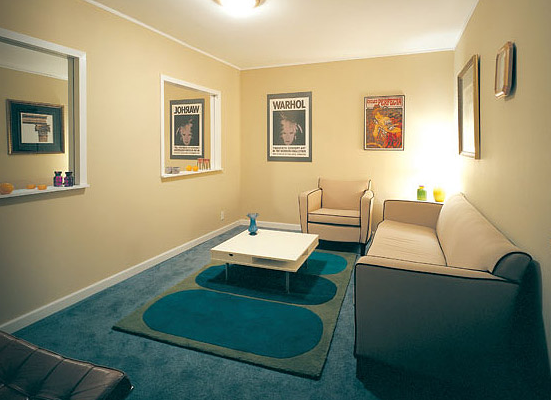
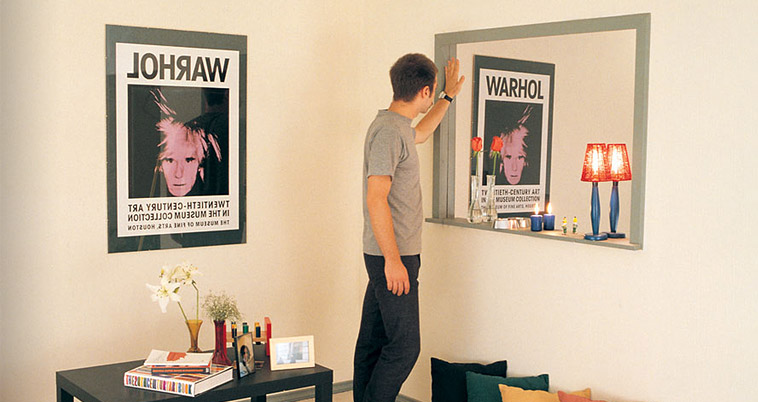
El Living (1998)
The theme of illusion is present in Erlich’s work again and again, anywhere from broken pieces of a door placed together to resemble shattered glass (Shattering Door, 2009) to a room with fogged glass with a sign on the outside that labels it “SMOKING ROOM” (Smoking Room, 2006) with a sofa inside to allow the viewer to contemplate the illusion and its meaning (arguably anti-tobacco, as if the smokers have a clouded view of the world). Erlich is quoted: “[…] the fact that something extraordinary can happen in such a simple way, technically and conceptually. That's an important factor in all of my projects. The viewer can trace the process; it's recognizable. The trick is not presented to deceive the viewer, but to be understood and resolved by him.”
 Shattering Door (2009)
Shattering Door (2009)
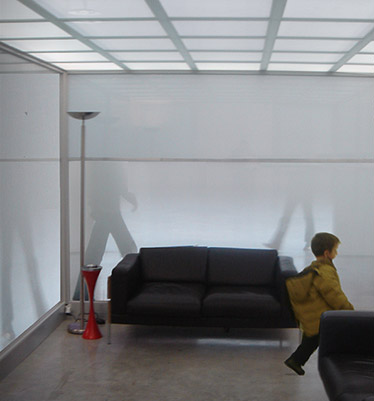
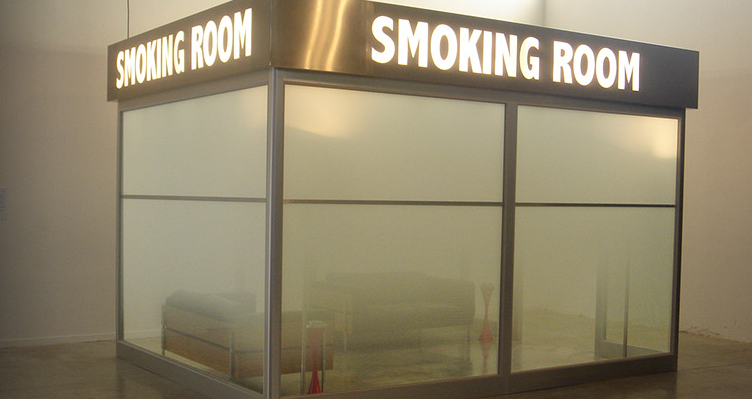
Smoking Room (2006)
The writing of one author, describing Erlich’s works as “jarring environments that momentarily threaten a sense of balance or space,” combined with the previous quote, seems to be hitting on Erlich’s deeper intentions besides making a fun house for art galleries. On a more conceptual level, Erlich’s installations bring up a lot of questions about what space is and how we as humans define space. In using mirrors, for example, as a way to create an illusion of another dimension, or one that seems impossible (such as in Bâtiment, 2004) can be read of a criticism of peoples’ lack of imagination on a day-to-day basis, and really seems to point out how people take concrete values of spaces for granted. Why should a cleverly designed lack-of-mirror seem like such a tricky illusion to most people? And especially since Erlich even declares that his installations are made to be simple and discovered even adds to these ideas: if they are so simple, why don’t people explore other types of space or illusions more often, rather than just sticking with the conventions of what defines a house or any other space?

Bâtiment (2004)
Erlich has created two pieces that revolve around ideas that are similar to what I want to explore in my sculpture: looking at water in a conceptual way. Firstly, his possibly most famous work, Swimming Pool (1999), is a relatively simple design that creates quite an illusion. From first glance, the installation looks like a swimming pool in the floor of a museum, with a ladder, underwater lights, and all. But upon further inspection, a viewer looking down into “pool” would see people standing and walking at the bottom, fully clothed and breathing. A staircase leads the viewer down inside the pool, and they are able to realize that it is just a simple illusion: a sheet of Plexiglas supports a couple inches of water at the top of the pool. The bottom of the pool becomes this enclosed space that appears to be underwater, although the viewer knows they are not, as they are dry, walking, and breathing (in one photograph, a child is even holding a balloon).
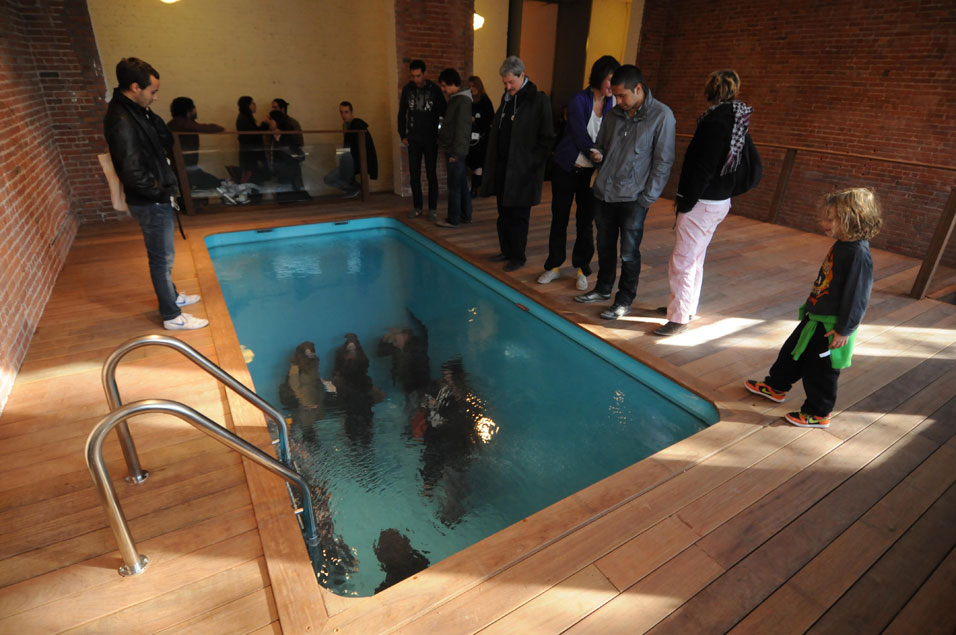

Swimming Pool (1999)
The second piece is Eau Molle (2003), what appears to be a fake strip of water in a building that actually has waterways in the springs of Toulouse, France. Again, upon further inspection, the piece is what can be most closely compared to a waterbed: it is a piece of plastic with a static blue wave design that has actual water underneath it. An audience member is able to walk on this “water,” touch it, or lay down on it. It gives the specific illusionary feeling of walking on water, something many people daydream to be able to do, and touching “water” without being immersed or getting wet. In this piece, it is not the lack of space, but more of the transformation of space: a person is very aware of the solidness of the water but can still experience it in a similar way, the water is the space.
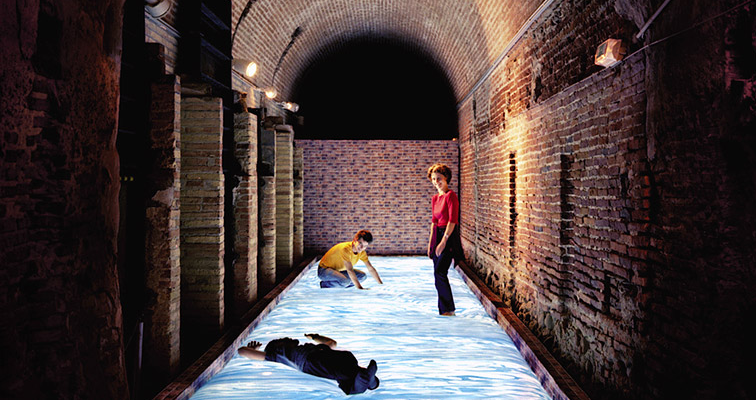

Eau Molle (2003)
There are similarities and differences in his works compared to what I want to do for my final sculpture. Like Erlich, conceptually, I want to create an illusion of water—but it won’t be as realistic as like Erlich’s Swimming Pool. Rather than in question of space, I want to explore ways in which a piece can translate swimming, or the feeling of being immersed in water (like Swimming Pool). Instead of being directly in that space, I am going to try to create that feeling by allowing a person to individually look into a space created with the underwater scene in mind. And although this may seem like a minor difference, my sculpture is going to be passive and in a frozen moment of time, whereas Erlich’s is constantly moving and actively engages the viewer. Like Erlich, I want my work to ask questions such as: What is water in terms of a space? What makes something similar to water, how can the feeling of swimming be recreated without actually being in water? How can a person successfully create the illusion of something as unique as water?
Bibliography:
“Interview: Leandro Erlich.” On ArtKrush.com. Accessed April 18 2010. <http://artkrush.com/175606>
Johnson, Ken. “Art in Review: Leandro Erlich—‘El Living.’” On The New York Times Online. Accessed April 18 2010. <http://www.nytimes.com/1999/10/08/arts/art-in-review-leandro-erlich-el-living.html?scp=2&sq=leandro%20erlich&st=cse>
“Leandro Erlich.” On Galerie Emanuel Perrotin Online. Accessed April 22 2010. <http://www.galerieperrotin.com/artiste-Leandro_Erlich-24.html>
“Leandro Erlich: Works.” On LeandroErlich.com. Accessed April 18 2010. <http://www.leandroerlich.com.ar/>
“Magical Swimming Pool Design by Leandro Erlich.” On Architecture Design Online. Accessed April 18 2010. <http://www.arnewde.com/architecture-design/magical-swimming-pool-design-by-leandro-erlich/>
* * *
Although best known for his abstract paintings, in his later years Willem de Kooning made sculptures as well. These sculptures are distinctly de Kooning, like his paintings—they are abstract versions, mainly of people, whose original material is clay (which was cast into bronze), which makes for a very organic-feeling sculpture. Author Harry F. Gaugh writes, "Linking Michelangelo and de Kooning, which at first seems either blasphemous or inane, actually amounts to a commingling of bodies distorted for emotional effect. Both artists retain the bulk of the human form while subjecting it to extremely difficult poses." (98) His specific style of lumping the clay together with little refinement gives a distinct character to each of his figures: for example, Clam Digger (1972), based on its title, the man appears to have become a sort of creature of the mud and water, and the shapes of his body resemble clams themselves. Even if he did not intend it, his sculpture implies a connection between a person and their work, transforming into each other.
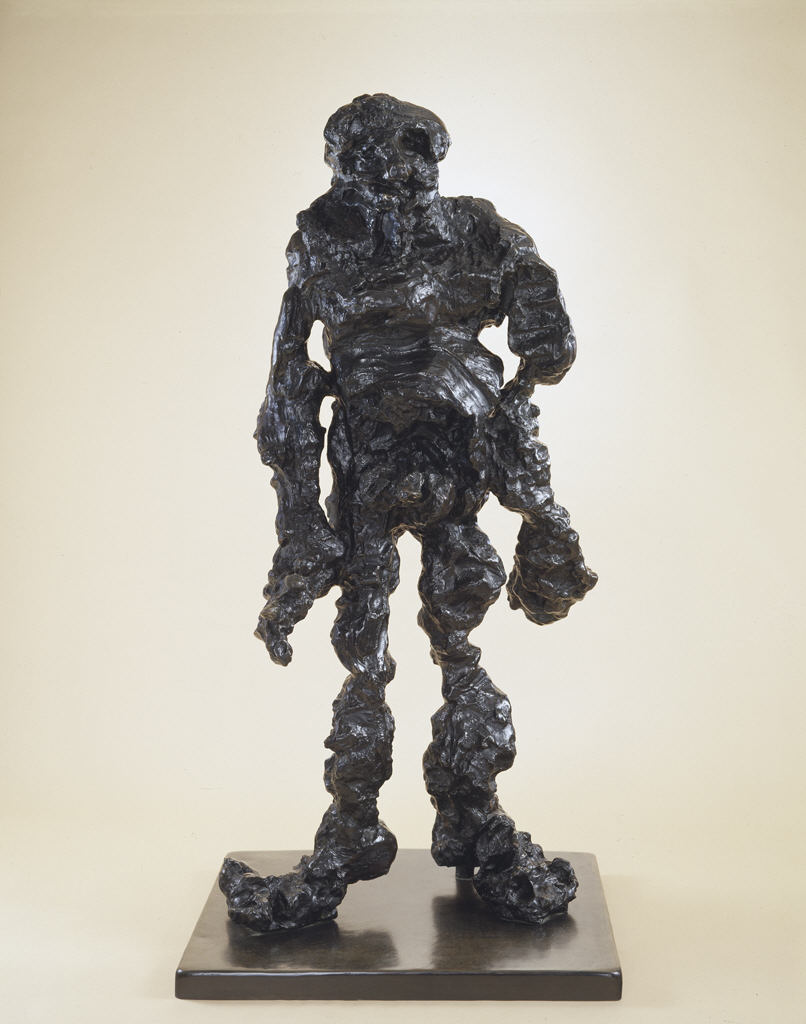
Clam Digger (1972)
As opposed to the clay resembling bulk that weighs down the figure, such as in Clam Digger, it also becomes a fluid form. In Cross-Legged Figure (1972), de Kooning has chosen to portray a twisting form, with its “arms” extended out. The shapes the clay retains seem to extend outwards into a flowing form: there is no division between the shoulder, elbow, hip, knee, etc. This figure, as opposed to Clam Digger, does not seem to have any real meaning behind it, but more serves as an alternate way to convey the figure, in a way that de Kooning seems to question conventional art: the figure can still be portrayed as fluid and beautiful in lumps of clay as it can be in carved marble.

Cross-Legged Figure (1972)
This fluidity can be seen again in his sculpture Large Torso (1974). Again, the clay takes on its own character, and in this particular sculpture, its form is very lumpy and has many pockets. Because of this, the sculpture seems to be shifting and moving, as if it were made out of molten lava. The specific pose suggests that the figure is slowly lifting its arms. Gaugh writes, “While decidedly monochromatic, de Kooning’s cast sculptures activate a coloristic play between light and shadow.” (101) The technique of forming the clay that de Kooning uses has an active dialogue with light, which attributes to the sculptures seemingly coming alive, as certain parts are lit up while others are cast in shadow. (And I am sure, if I could have seen these in real life, the shadow the sculpture casts is a part of it as well). De Kooning has certainly developed a way to give an inanimate object the apparition of life, as they resemble the sort of creations fabled to be made by a mad scientist, not human but possessing certain humanistic qualities.

Large Torso (1974)
This “molten lava” characteristic can be seen in his Head series as well. For example, in Head No. 3 (1973), although the head is staying together and not, for instance, dripping on its base, its features still seem to be slowly melting off of its face. What also adds to these Heads’ characters is the fact that the normal features of the face (eyes, nose, mouth, etc.) are something the viewer has to find, as they are not so distinct or obvious. In Head No. 4 (1973), its features more become the space not occupied by clay: there are holes that become the eyes and mouth, making it look like a gaping, even dying, head, as it becomes more skull-like but again, the clay looks as though it is melting.
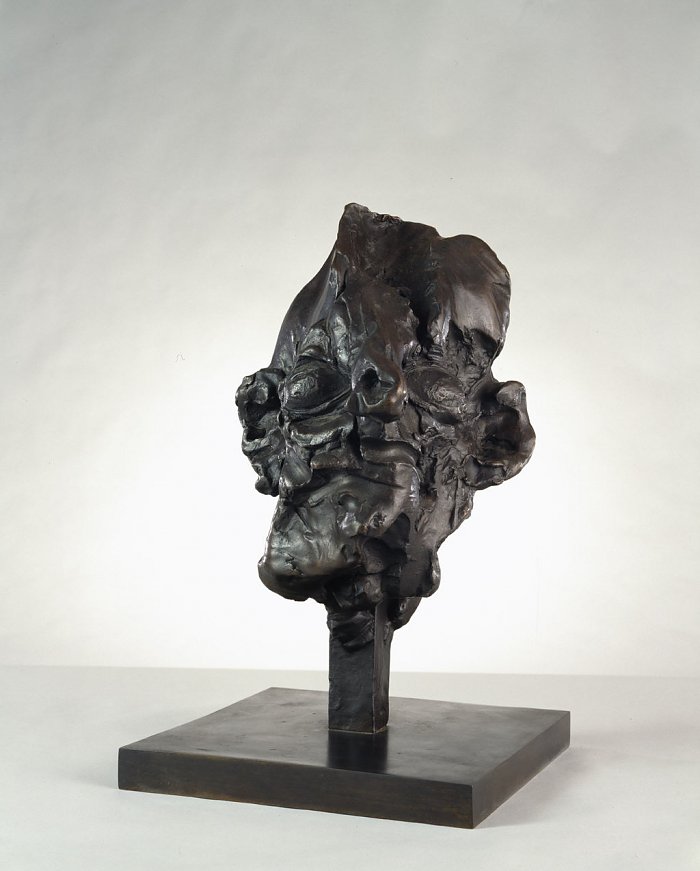
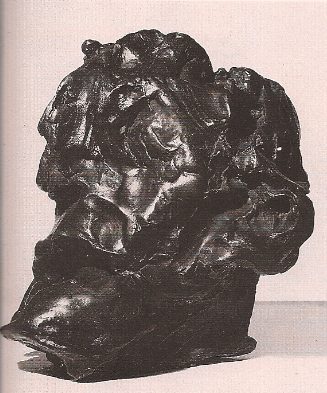
Head No. 3 (1973); Head No. 4 (1973)
This style that de Kooning developed shows his talent in taking a material often used for very static forms—clay—and giving it vitality and movement. The forms, of distinguishable shape or not, all posses a distinct type of movement in their shape and bulk that responds specifically to light and shadow, which gives them all a distinct presence. In many of his works, de Kooning was also able to convey the human figure without retaining much of its characteristics: even fat human bodies do not resemble lumps of clay pushed together. His work goes in line with abstract work; with the same sorts of questions of, What exactly is the human figure and what characteristics does a form have to possess in order to resemble it?
In my own sculpture, I am focusing on using paper to convey a human figure submerged. Although paper is very unlike water, as unrefined clay is very unlike skin or muscle, I hope to make the connection that de Kooning was able to make; so that when a viewer sees a form of paper, they will be able to guess based on its form that it is a human figure underwater. The play of light and shadow is also something that specifically speaks to my piece, as the figure will be enclosed but only for a controlled amount of light entering the space from above, like water. As light and shadow gives de Kooning’s pieces a specific kind of vitality, I hope it will be the same for my figure: I want the light that enters to play with the figure the same way that light through water does on forms, and hopefully the figure will not appear extremely static, although my goal is to portray a moment of time underwater.
Bibliography:
Gaugh, Harry F. Willem de Kooning. New York: Abbeville Press, 1983.
Kramer, Hilton. “Art: The Sculptures of Willem de Kooning Shown.” On The New York Times Online. Accessed April 24 2010. <http://select.nytimes.com/gst/abstract.html?res=F30A11FC385E127A93C1A8178BD95F468785F9&scp=2&sq=de%20kooning%20sculpture&st=cse>
Russel, John. “Art: The Sculpture of Willem de Kooning.” On The New York Times Online. Accessed April 23 2010. < http://www.nytimes.com/1983/05/20/arts/art-the-sculpture-of-willem-de-kooning.html?&pagewanted=1>
* * *
Back to Index
This page was last updated:
April 24, 2010 4:32 PM